Global and Cross-cultural Marketing Report: H&M Marketing Strategies
VerifiedAdded on 2020/10/22
|11
|3941
|338
Report
AI Summary
This report provides an in-depth analysis of H&M's global and cross-cultural marketing strategies, focusing on its potential entry into the Tanzanian market. It begins with an introduction to cross-cultural marketing and provides background information on Tanzania, including its culture, climate, and economic factors. A PESTLE analysis is conducted to evaluate the political, economic, sociological, technological, legal, and environmental factors influencing H&M's business in Tanzania. The report then explores various market entry modes, such as exporting, licensing, mergers and acquisitions, and strategic alliances, recommending the most suitable approach for H&M. Finally, it discusses the marketing mix elements and target market considerations for H&M in Tanzania, offering insights into how the company can successfully establish and grow its presence in this market. The report highlights the importance of understanding cultural nuances and adapting marketing strategies to the local context. The report also includes a detailed analysis of environmental factors.
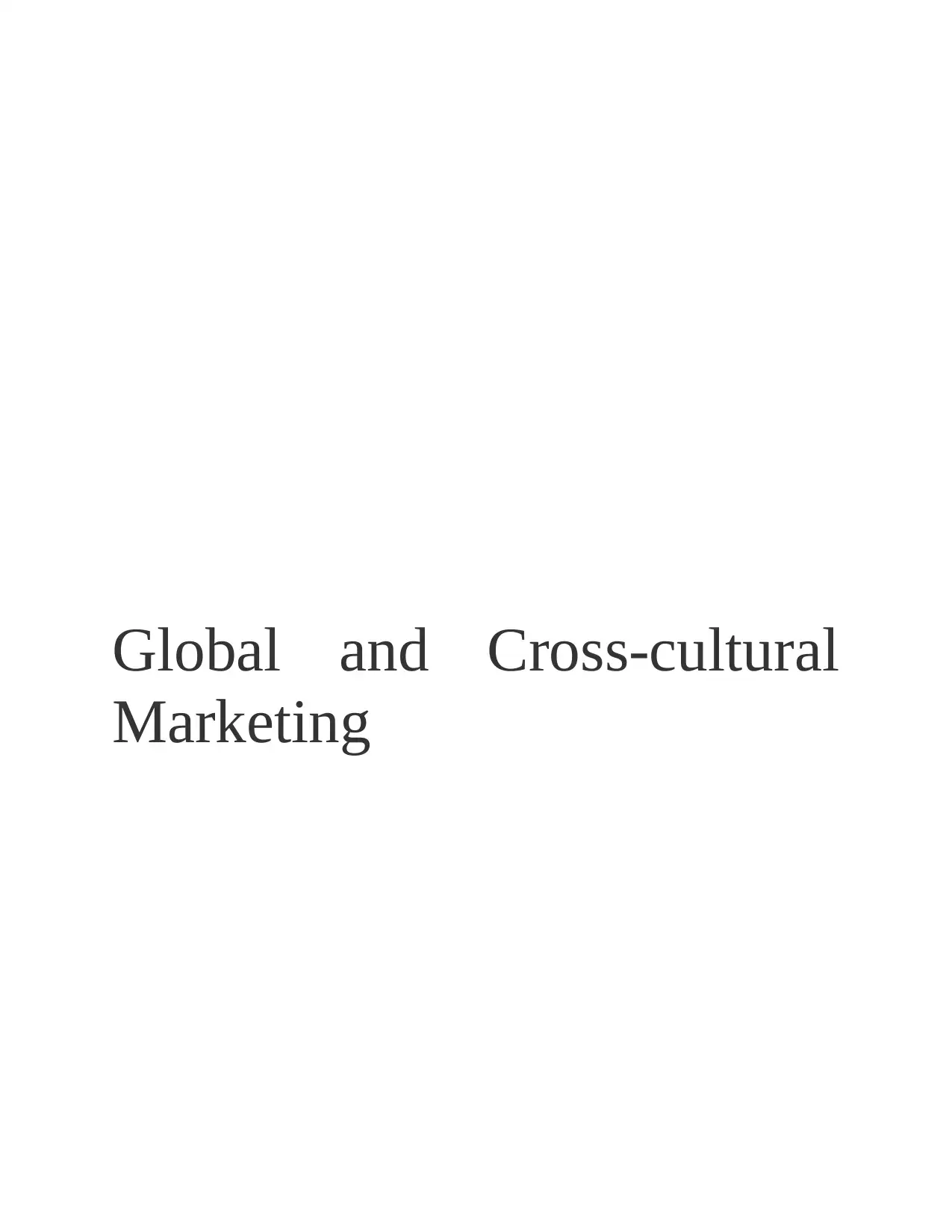
Global and Cross-cultural
Marketing
Marketing
Paraphrase This Document
Need a fresh take? Get an instant paraphrase of this document with our AI Paraphraser
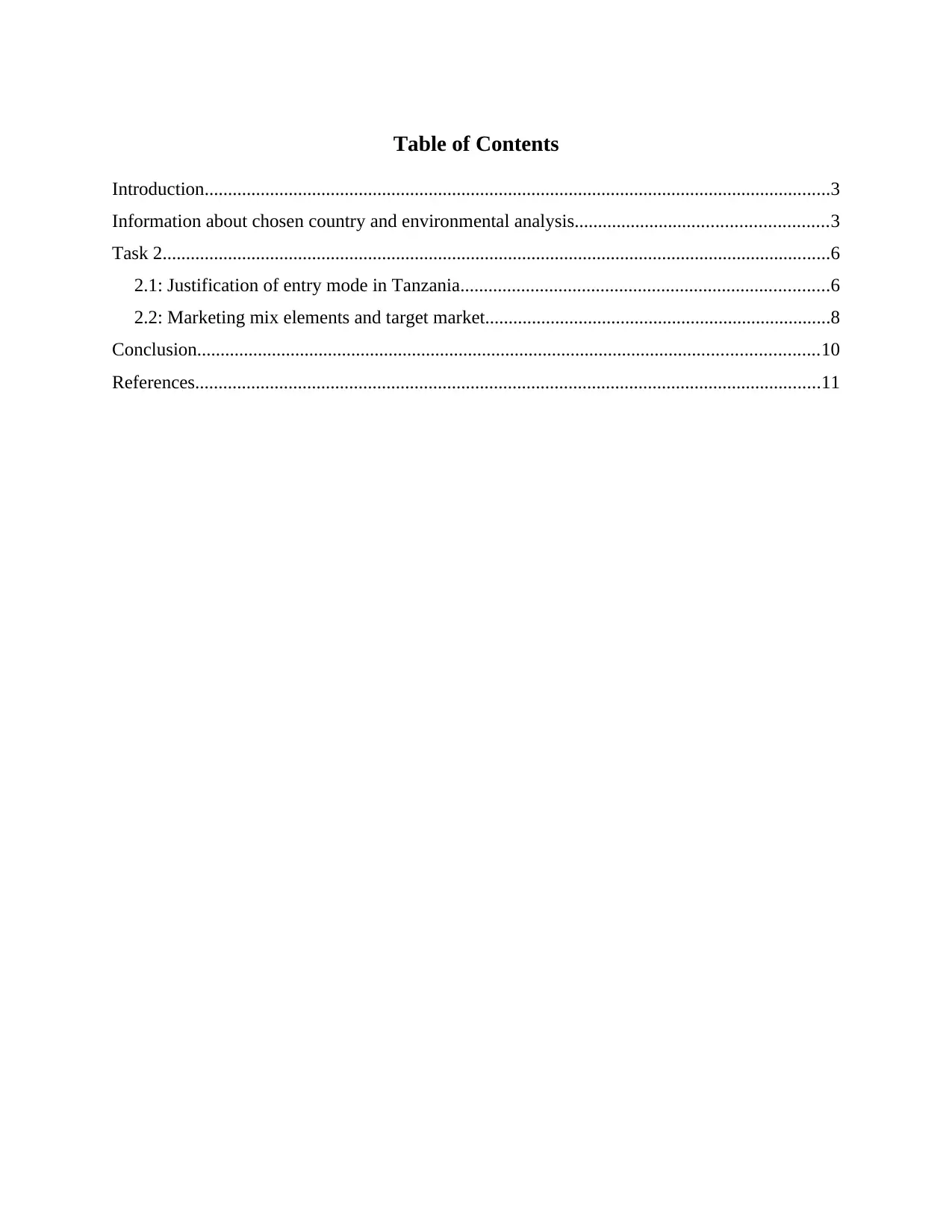
Table of Contents
Introduction......................................................................................................................................3
Information about chosen country and environmental analysis......................................................3
Task 2...............................................................................................................................................6
2.1: Justification of entry mode in Tanzania...............................................................................6
2.2: Marketing mix elements and target market..........................................................................8
Conclusion.....................................................................................................................................10
References......................................................................................................................................11
Introduction......................................................................................................................................3
Information about chosen country and environmental analysis......................................................3
Task 2...............................................................................................................................................6
2.1: Justification of entry mode in Tanzania...............................................................................6
2.2: Marketing mix elements and target market..........................................................................8
Conclusion.....................................................................................................................................10
References......................................................................................................................................11
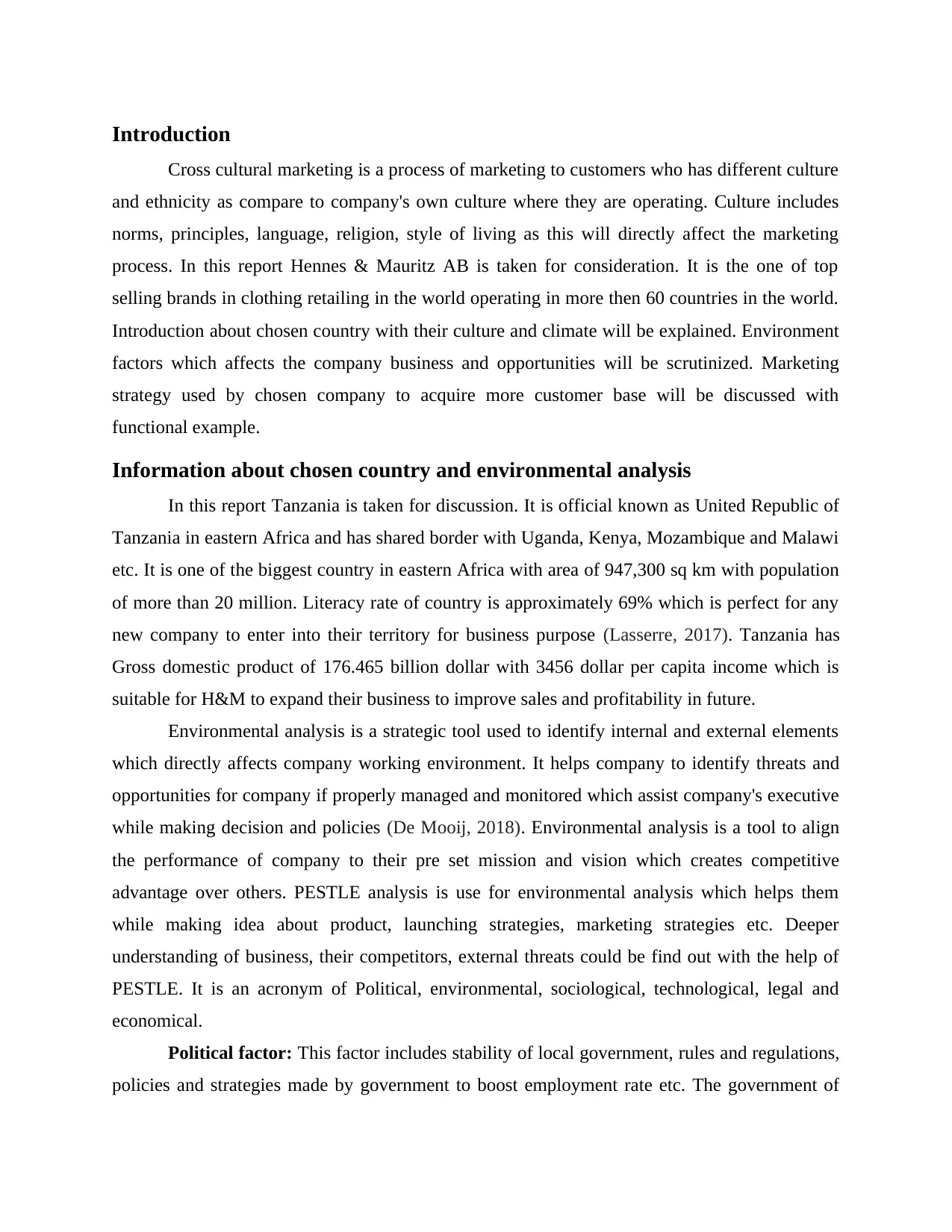
Introduction
Cross cultural marketing is a process of marketing to customers who has different culture
and ethnicity as compare to company's own culture where they are operating. Culture includes
norms, principles, language, religion, style of living as this will directly affect the marketing
process. In this report Hennes & Mauritz AB is taken for consideration. It is the one of top
selling brands in clothing retailing in the world operating in more then 60 countries in the world.
Introduction about chosen country with their culture and climate will be explained. Environment
factors which affects the company business and opportunities will be scrutinized. Marketing
strategy used by chosen company to acquire more customer base will be discussed with
functional example.
Information about chosen country and environmental analysis
In this report Tanzania is taken for discussion. It is official known as United Republic of
Tanzania in eastern Africa and has shared border with Uganda, Kenya, Mozambique and Malawi
etc. It is one of the biggest country in eastern Africa with area of 947,300 sq km with population
of more than 20 million. Literacy rate of country is approximately 69% which is perfect for any
new company to enter into their territory for business purpose (Lasserre, 2017). Tanzania has
Gross domestic product of 176.465 billion dollar with 3456 dollar per capita income which is
suitable for H&M to expand their business to improve sales and profitability in future.
Environmental analysis is a strategic tool used to identify internal and external elements
which directly affects company working environment. It helps company to identify threats and
opportunities for company if properly managed and monitored which assist company's executive
while making decision and policies (De Mooij, 2018). Environmental analysis is a tool to align
the performance of company to their pre set mission and vision which creates competitive
advantage over others. PESTLE analysis is use for environmental analysis which helps them
while making idea about product, launching strategies, marketing strategies etc. Deeper
understanding of business, their competitors, external threats could be find out with the help of
PESTLE. It is an acronym of Political, environmental, sociological, technological, legal and
economical.
Political factor: This factor includes stability of local government, rules and regulations,
policies and strategies made by government to boost employment rate etc. The government of
Cross cultural marketing is a process of marketing to customers who has different culture
and ethnicity as compare to company's own culture where they are operating. Culture includes
norms, principles, language, religion, style of living as this will directly affect the marketing
process. In this report Hennes & Mauritz AB is taken for consideration. It is the one of top
selling brands in clothing retailing in the world operating in more then 60 countries in the world.
Introduction about chosen country with their culture and climate will be explained. Environment
factors which affects the company business and opportunities will be scrutinized. Marketing
strategy used by chosen company to acquire more customer base will be discussed with
functional example.
Information about chosen country and environmental analysis
In this report Tanzania is taken for discussion. It is official known as United Republic of
Tanzania in eastern Africa and has shared border with Uganda, Kenya, Mozambique and Malawi
etc. It is one of the biggest country in eastern Africa with area of 947,300 sq km with population
of more than 20 million. Literacy rate of country is approximately 69% which is perfect for any
new company to enter into their territory for business purpose (Lasserre, 2017). Tanzania has
Gross domestic product of 176.465 billion dollar with 3456 dollar per capita income which is
suitable for H&M to expand their business to improve sales and profitability in future.
Environmental analysis is a strategic tool used to identify internal and external elements
which directly affects company working environment. It helps company to identify threats and
opportunities for company if properly managed and monitored which assist company's executive
while making decision and policies (De Mooij, 2018). Environmental analysis is a tool to align
the performance of company to their pre set mission and vision which creates competitive
advantage over others. PESTLE analysis is use for environmental analysis which helps them
while making idea about product, launching strategies, marketing strategies etc. Deeper
understanding of business, their competitors, external threats could be find out with the help of
PESTLE. It is an acronym of Political, environmental, sociological, technological, legal and
economical.
Political factor: This factor includes stability of local government, rules and regulations,
policies and strategies made by government to boost employment rate etc. The government of
⊘ This is a preview!⊘
Do you want full access?
Subscribe today to unlock all pages.

Trusted by 1+ million students worldwide
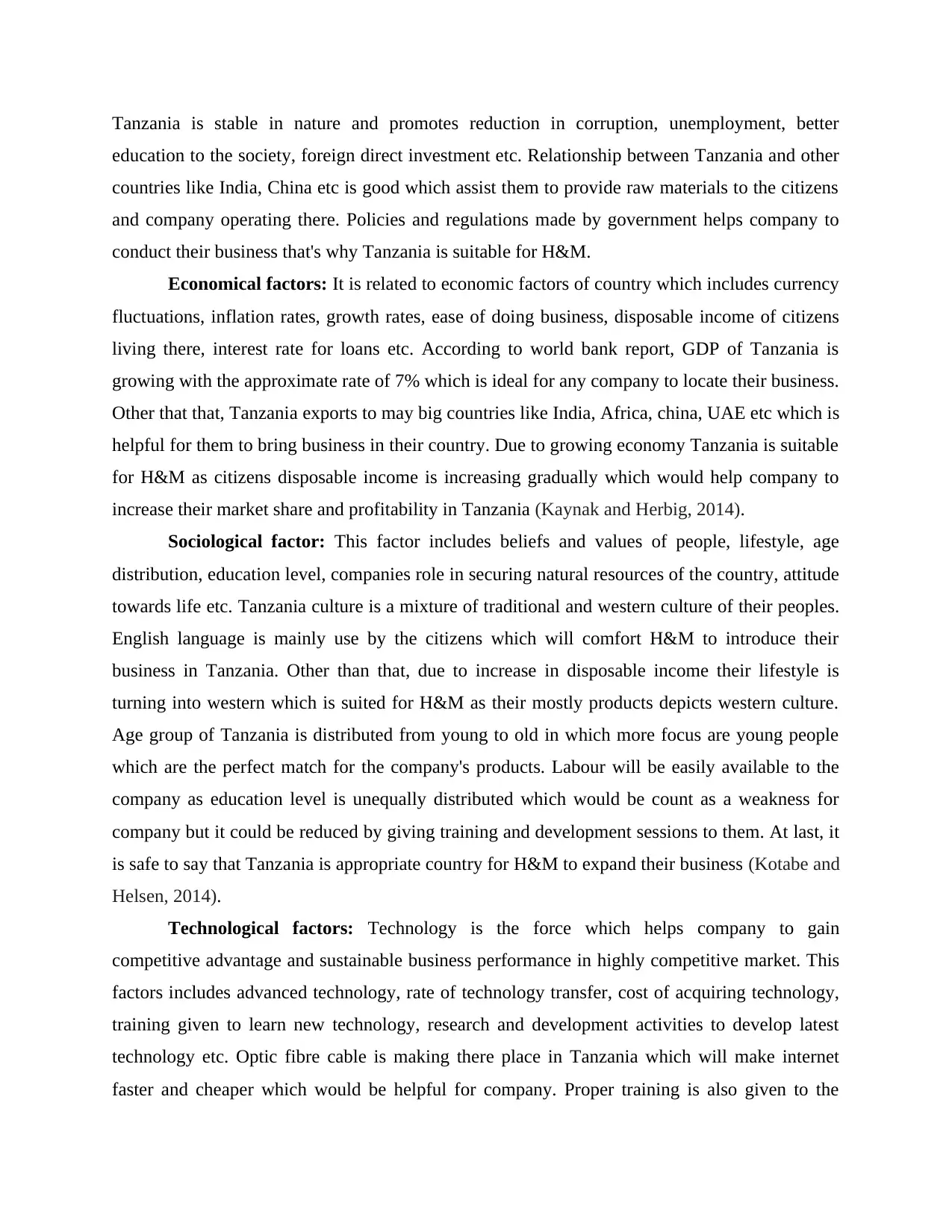
Tanzania is stable in nature and promotes reduction in corruption, unemployment, better
education to the society, foreign direct investment etc. Relationship between Tanzania and other
countries like India, China etc is good which assist them to provide raw materials to the citizens
and company operating there. Policies and regulations made by government helps company to
conduct their business that's why Tanzania is suitable for H&M.
Economical factors: It is related to economic factors of country which includes currency
fluctuations, inflation rates, growth rates, ease of doing business, disposable income of citizens
living there, interest rate for loans etc. According to world bank report, GDP of Tanzania is
growing with the approximate rate of 7% which is ideal for any company to locate their business.
Other that that, Tanzania exports to may big countries like India, Africa, china, UAE etc which is
helpful for them to bring business in their country. Due to growing economy Tanzania is suitable
for H&M as citizens disposable income is increasing gradually which would help company to
increase their market share and profitability in Tanzania (Kaynak and Herbig, 2014).
Sociological factor: This factor includes beliefs and values of people, lifestyle, age
distribution, education level, companies role in securing natural resources of the country, attitude
towards life etc. Tanzania culture is a mixture of traditional and western culture of their peoples.
English language is mainly use by the citizens which will comfort H&M to introduce their
business in Tanzania. Other than that, due to increase in disposable income their lifestyle is
turning into western which is suited for H&M as their mostly products depicts western culture.
Age group of Tanzania is distributed from young to old in which more focus are young people
which are the perfect match for the company's products. Labour will be easily available to the
company as education level is unequally distributed which would be count as a weakness for
company but it could be reduced by giving training and development sessions to them. At last, it
is safe to say that Tanzania is appropriate country for H&M to expand their business (Kotabe and
Helsen, 2014).
Technological factors: Technology is the force which helps company to gain
competitive advantage and sustainable business performance in highly competitive market. This
factors includes advanced technology, rate of technology transfer, cost of acquiring technology,
training given to learn new technology, research and development activities to develop latest
technology etc. Optic fibre cable is making there place in Tanzania which will make internet
faster and cheaper which would be helpful for company. Proper training is also given to the
education to the society, foreign direct investment etc. Relationship between Tanzania and other
countries like India, China etc is good which assist them to provide raw materials to the citizens
and company operating there. Policies and regulations made by government helps company to
conduct their business that's why Tanzania is suitable for H&M.
Economical factors: It is related to economic factors of country which includes currency
fluctuations, inflation rates, growth rates, ease of doing business, disposable income of citizens
living there, interest rate for loans etc. According to world bank report, GDP of Tanzania is
growing with the approximate rate of 7% which is ideal for any company to locate their business.
Other that that, Tanzania exports to may big countries like India, Africa, china, UAE etc which is
helpful for them to bring business in their country. Due to growing economy Tanzania is suitable
for H&M as citizens disposable income is increasing gradually which would help company to
increase their market share and profitability in Tanzania (Kaynak and Herbig, 2014).
Sociological factor: This factor includes beliefs and values of people, lifestyle, age
distribution, education level, companies role in securing natural resources of the country, attitude
towards life etc. Tanzania culture is a mixture of traditional and western culture of their peoples.
English language is mainly use by the citizens which will comfort H&M to introduce their
business in Tanzania. Other than that, due to increase in disposable income their lifestyle is
turning into western which is suited for H&M as their mostly products depicts western culture.
Age group of Tanzania is distributed from young to old in which more focus are young people
which are the perfect match for the company's products. Labour will be easily available to the
company as education level is unequally distributed which would be count as a weakness for
company but it could be reduced by giving training and development sessions to them. At last, it
is safe to say that Tanzania is appropriate country for H&M to expand their business (Kotabe and
Helsen, 2014).
Technological factors: Technology is the force which helps company to gain
competitive advantage and sustainable business performance in highly competitive market. This
factors includes advanced technology, rate of technology transfer, cost of acquiring technology,
training given to learn new technology, research and development activities to develop latest
technology etc. Optic fibre cable is making there place in Tanzania which will make internet
faster and cheaper which would be helpful for company. Proper training is also given to the
Paraphrase This Document
Need a fresh take? Get an instant paraphrase of this document with our AI Paraphraser
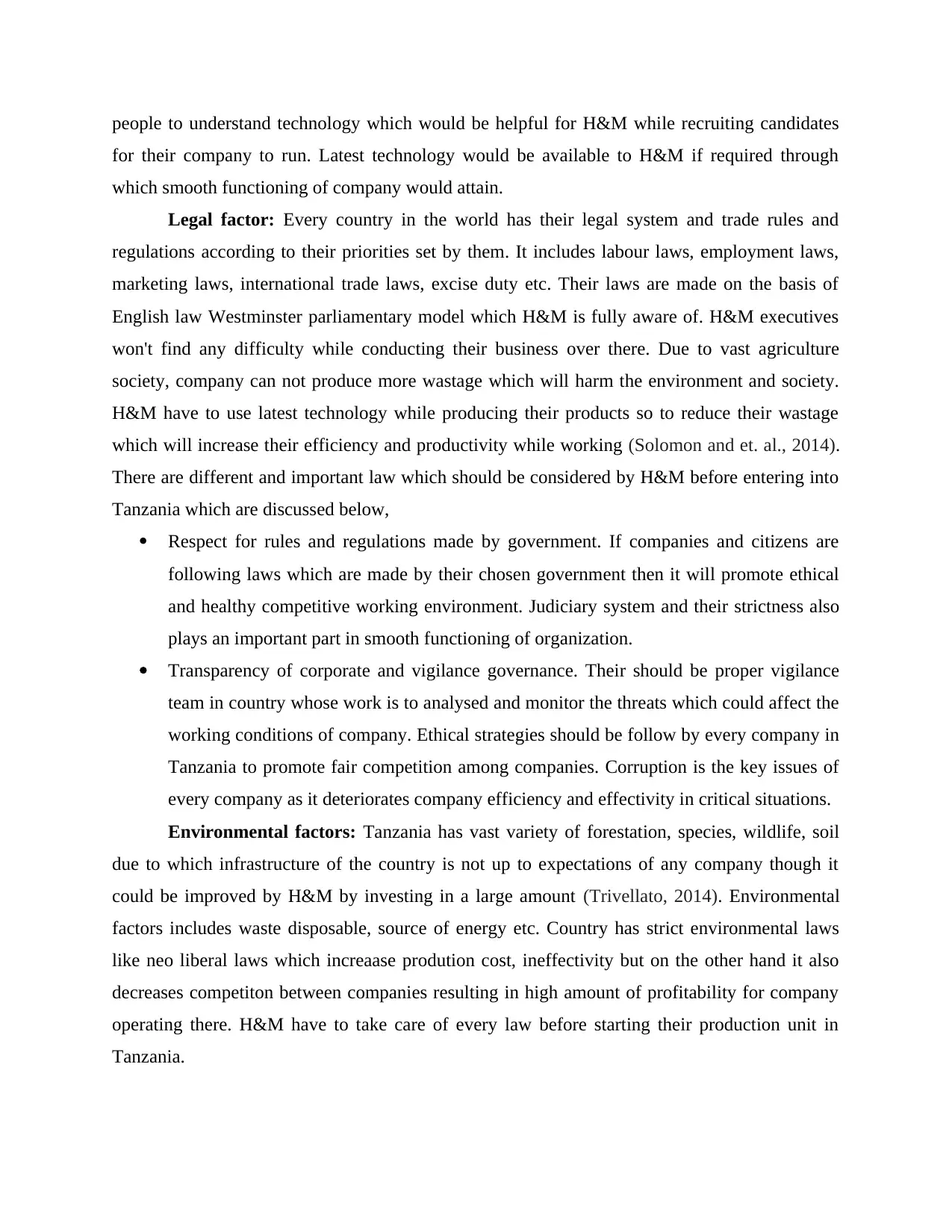
people to understand technology which would be helpful for H&M while recruiting candidates
for their company to run. Latest technology would be available to H&M if required through
which smooth functioning of company would attain.
Legal factor: Every country in the world has their legal system and trade rules and
regulations according to their priorities set by them. It includes labour laws, employment laws,
marketing laws, international trade laws, excise duty etc. Their laws are made on the basis of
English law Westminster parliamentary model which H&M is fully aware of. H&M executives
won't find any difficulty while conducting their business over there. Due to vast agriculture
society, company can not produce more wastage which will harm the environment and society.
H&M have to use latest technology while producing their products so to reduce their wastage
which will increase their efficiency and productivity while working (Solomon and et. al., 2014).
There are different and important law which should be considered by H&M before entering into
Tanzania which are discussed below,
Respect for rules and regulations made by government. If companies and citizens are
following laws which are made by their chosen government then it will promote ethical
and healthy competitive working environment. Judiciary system and their strictness also
plays an important part in smooth functioning of organization.
Transparency of corporate and vigilance governance. Their should be proper vigilance
team in country whose work is to analysed and monitor the threats which could affect the
working conditions of company. Ethical strategies should be follow by every company in
Tanzania to promote fair competition among companies. Corruption is the key issues of
every company as it deteriorates company efficiency and effectivity in critical situations.
Environmental factors: Tanzania has vast variety of forestation, species, wildlife, soil
due to which infrastructure of the country is not up to expectations of any company though it
could be improved by H&M by investing in a large amount (Trivellato, 2014). Environmental
factors includes waste disposable, source of energy etc. Country has strict environmental laws
like neo liberal laws which increaase prodution cost, ineffectivity but on the other hand it also
decreases competiton between companies resulting in high amount of profitability for company
operating there. H&M have to take care of every law before starting their production unit in
Tanzania.
for their company to run. Latest technology would be available to H&M if required through
which smooth functioning of company would attain.
Legal factor: Every country in the world has their legal system and trade rules and
regulations according to their priorities set by them. It includes labour laws, employment laws,
marketing laws, international trade laws, excise duty etc. Their laws are made on the basis of
English law Westminster parliamentary model which H&M is fully aware of. H&M executives
won't find any difficulty while conducting their business over there. Due to vast agriculture
society, company can not produce more wastage which will harm the environment and society.
H&M have to use latest technology while producing their products so to reduce their wastage
which will increase their efficiency and productivity while working (Solomon and et. al., 2014).
There are different and important law which should be considered by H&M before entering into
Tanzania which are discussed below,
Respect for rules and regulations made by government. If companies and citizens are
following laws which are made by their chosen government then it will promote ethical
and healthy competitive working environment. Judiciary system and their strictness also
plays an important part in smooth functioning of organization.
Transparency of corporate and vigilance governance. Their should be proper vigilance
team in country whose work is to analysed and monitor the threats which could affect the
working conditions of company. Ethical strategies should be follow by every company in
Tanzania to promote fair competition among companies. Corruption is the key issues of
every company as it deteriorates company efficiency and effectivity in critical situations.
Environmental factors: Tanzania has vast variety of forestation, species, wildlife, soil
due to which infrastructure of the country is not up to expectations of any company though it
could be improved by H&M by investing in a large amount (Trivellato, 2014). Environmental
factors includes waste disposable, source of energy etc. Country has strict environmental laws
like neo liberal laws which increaase prodution cost, ineffectivity but on the other hand it also
decreases competiton between companies resulting in high amount of profitability for company
operating there. H&M have to take care of every law before starting their production unit in
Tanzania.
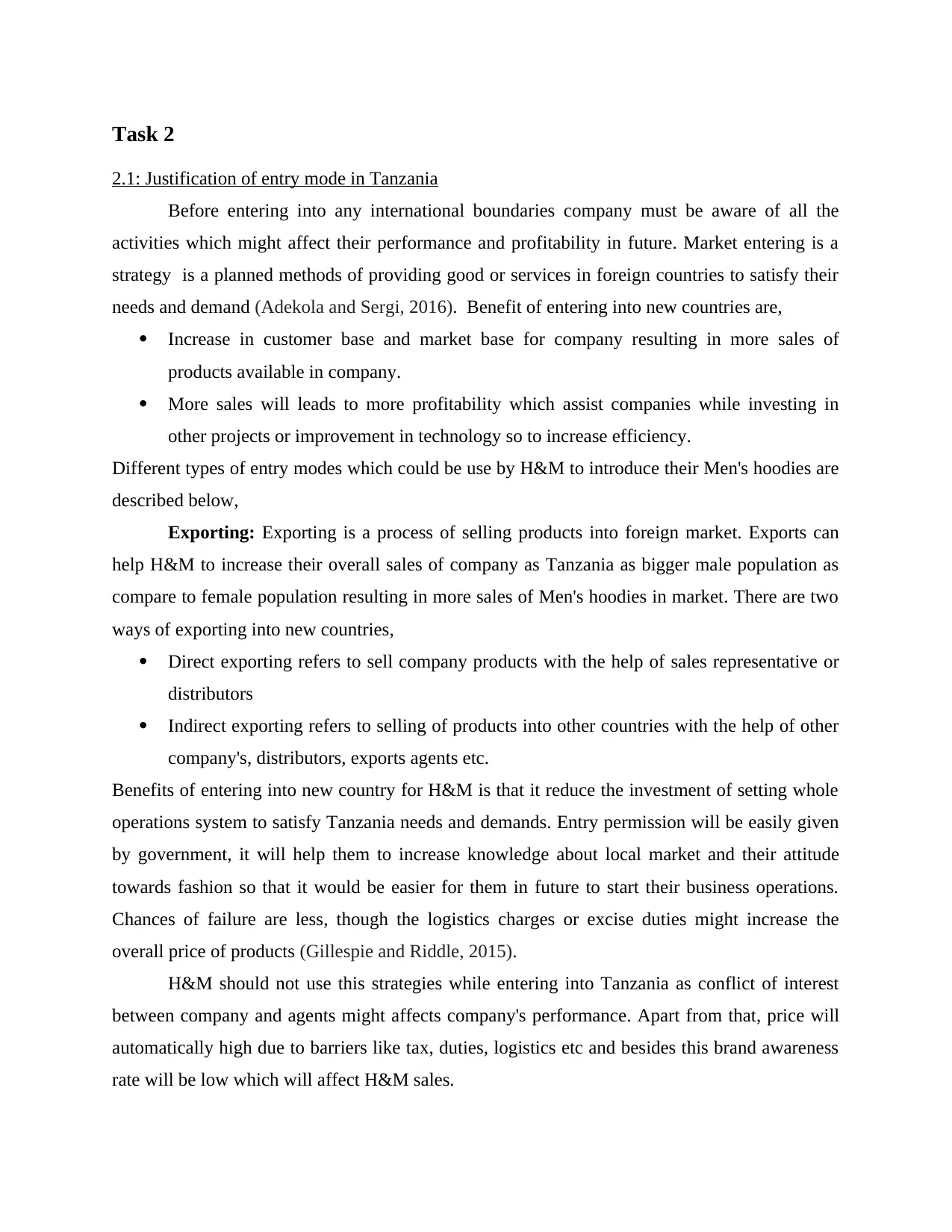
Task 2
2.1: Justification of entry mode in Tanzania
Before entering into any international boundaries company must be aware of all the
activities which might affect their performance and profitability in future. Market entering is a
strategy is a planned methods of providing good or services in foreign countries to satisfy their
needs and demand (Adekola and Sergi, 2016). Benefit of entering into new countries are,
Increase in customer base and market base for company resulting in more sales of
products available in company.
More sales will leads to more profitability which assist companies while investing in
other projects or improvement in technology so to increase efficiency.
Different types of entry modes which could be use by H&M to introduce their Men's hoodies are
described below,
Exporting: Exporting is a process of selling products into foreign market. Exports can
help H&M to increase their overall sales of company as Tanzania as bigger male population as
compare to female population resulting in more sales of Men's hoodies in market. There are two
ways of exporting into new countries,
Direct exporting refers to sell company products with the help of sales representative or
distributors
Indirect exporting refers to selling of products into other countries with the help of other
company's, distributors, exports agents etc.
Benefits of entering into new country for H&M is that it reduce the investment of setting whole
operations system to satisfy Tanzania needs and demands. Entry permission will be easily given
by government, it will help them to increase knowledge about local market and their attitude
towards fashion so that it would be easier for them in future to start their business operations.
Chances of failure are less, though the logistics charges or excise duties might increase the
overall price of products (Gillespie and Riddle, 2015).
H&M should not use this strategies while entering into Tanzania as conflict of interest
between company and agents might affects company's performance. Apart from that, price will
automatically high due to barriers like tax, duties, logistics etc and besides this brand awareness
rate will be low which will affect H&M sales.
2.1: Justification of entry mode in Tanzania
Before entering into any international boundaries company must be aware of all the
activities which might affect their performance and profitability in future. Market entering is a
strategy is a planned methods of providing good or services in foreign countries to satisfy their
needs and demand (Adekola and Sergi, 2016). Benefit of entering into new countries are,
Increase in customer base and market base for company resulting in more sales of
products available in company.
More sales will leads to more profitability which assist companies while investing in
other projects or improvement in technology so to increase efficiency.
Different types of entry modes which could be use by H&M to introduce their Men's hoodies are
described below,
Exporting: Exporting is a process of selling products into foreign market. Exports can
help H&M to increase their overall sales of company as Tanzania as bigger male population as
compare to female population resulting in more sales of Men's hoodies in market. There are two
ways of exporting into new countries,
Direct exporting refers to sell company products with the help of sales representative or
distributors
Indirect exporting refers to selling of products into other countries with the help of other
company's, distributors, exports agents etc.
Benefits of entering into new country for H&M is that it reduce the investment of setting whole
operations system to satisfy Tanzania needs and demands. Entry permission will be easily given
by government, it will help them to increase knowledge about local market and their attitude
towards fashion so that it would be easier for them in future to start their business operations.
Chances of failure are less, though the logistics charges or excise duties might increase the
overall price of products (Gillespie and Riddle, 2015).
H&M should not use this strategies while entering into Tanzania as conflict of interest
between company and agents might affects company's performance. Apart from that, price will
automatically high due to barriers like tax, duties, logistics etc and besides this brand awareness
rate will be low which will affect H&M sales.
⊘ This is a preview!⊘
Do you want full access?
Subscribe today to unlock all pages.

Trusted by 1+ million students worldwide
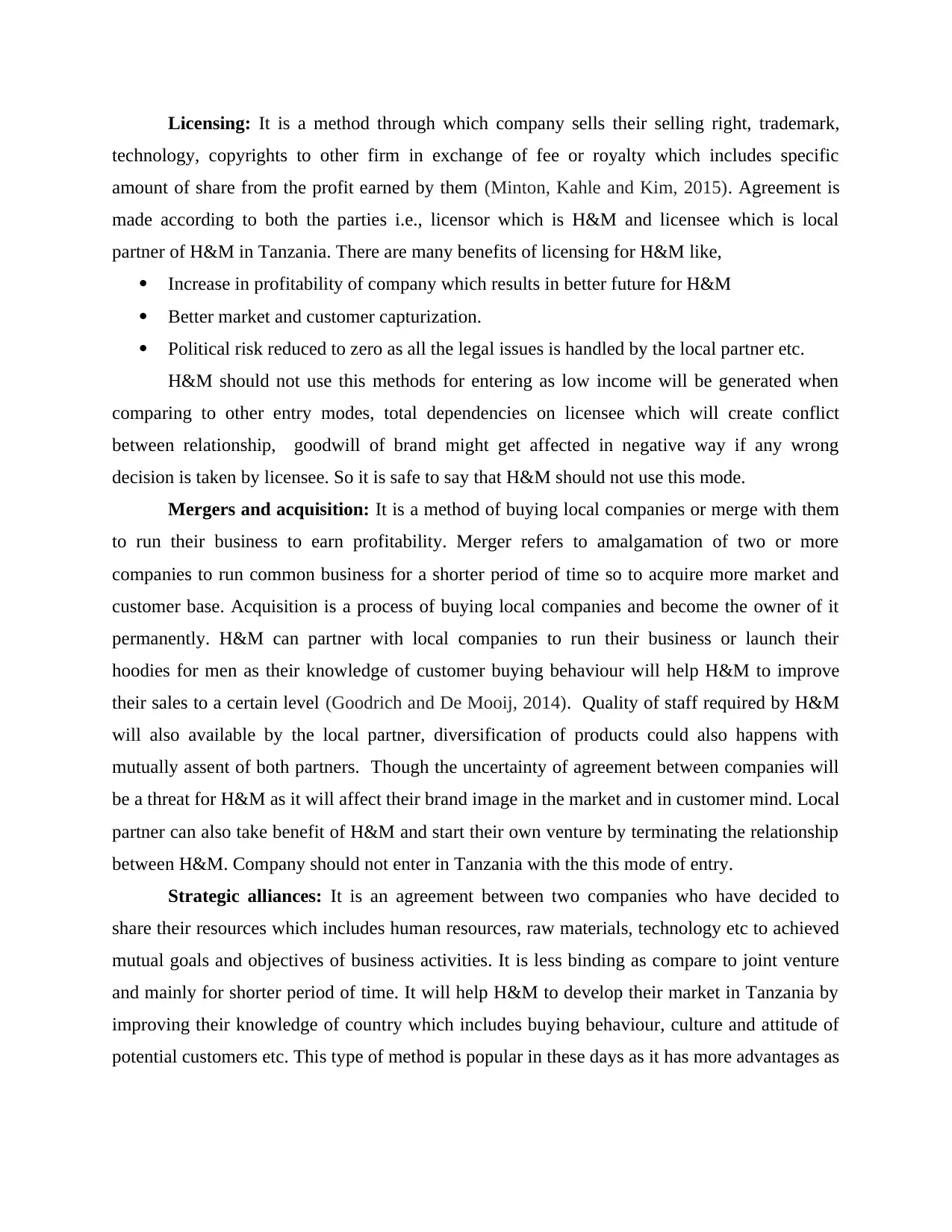
Licensing: It is a method through which company sells their selling right, trademark,
technology, copyrights to other firm in exchange of fee or royalty which includes specific
amount of share from the profit earned by them (Minton, Kahle and Kim, 2015). Agreement is
made according to both the parties i.e., licensor which is H&M and licensee which is local
partner of H&M in Tanzania. There are many benefits of licensing for H&M like,
Increase in profitability of company which results in better future for H&M
Better market and customer capturization.
Political risk reduced to zero as all the legal issues is handled by the local partner etc.
H&M should not use this methods for entering as low income will be generated when
comparing to other entry modes, total dependencies on licensee which will create conflict
between relationship, goodwill of brand might get affected in negative way if any wrong
decision is taken by licensee. So it is safe to say that H&M should not use this mode.
Mergers and acquisition: It is a method of buying local companies or merge with them
to run their business to earn profitability. Merger refers to amalgamation of two or more
companies to run common business for a shorter period of time so to acquire more market and
customer base. Acquisition is a process of buying local companies and become the owner of it
permanently. H&M can partner with local companies to run their business or launch their
hoodies for men as their knowledge of customer buying behaviour will help H&M to improve
their sales to a certain level (Goodrich and De Mooij, 2014). Quality of staff required by H&M
will also available by the local partner, diversification of products could also happens with
mutually assent of both partners. Though the uncertainty of agreement between companies will
be a threat for H&M as it will affect their brand image in the market and in customer mind. Local
partner can also take benefit of H&M and start their own venture by terminating the relationship
between H&M. Company should not enter in Tanzania with the this mode of entry.
Strategic alliances: It is an agreement between two companies who have decided to
share their resources which includes human resources, raw materials, technology etc to achieved
mutual goals and objectives of business activities. It is less binding as compare to joint venture
and mainly for shorter period of time. It will help H&M to develop their market in Tanzania by
improving their knowledge of country which includes buying behaviour, culture and attitude of
potential customers etc. This type of method is popular in these days as it has more advantages as
technology, copyrights to other firm in exchange of fee or royalty which includes specific
amount of share from the profit earned by them (Minton, Kahle and Kim, 2015). Agreement is
made according to both the parties i.e., licensor which is H&M and licensee which is local
partner of H&M in Tanzania. There are many benefits of licensing for H&M like,
Increase in profitability of company which results in better future for H&M
Better market and customer capturization.
Political risk reduced to zero as all the legal issues is handled by the local partner etc.
H&M should not use this methods for entering as low income will be generated when
comparing to other entry modes, total dependencies on licensee which will create conflict
between relationship, goodwill of brand might get affected in negative way if any wrong
decision is taken by licensee. So it is safe to say that H&M should not use this mode.
Mergers and acquisition: It is a method of buying local companies or merge with them
to run their business to earn profitability. Merger refers to amalgamation of two or more
companies to run common business for a shorter period of time so to acquire more market and
customer base. Acquisition is a process of buying local companies and become the owner of it
permanently. H&M can partner with local companies to run their business or launch their
hoodies for men as their knowledge of customer buying behaviour will help H&M to improve
their sales to a certain level (Goodrich and De Mooij, 2014). Quality of staff required by H&M
will also available by the local partner, diversification of products could also happens with
mutually assent of both partners. Though the uncertainty of agreement between companies will
be a threat for H&M as it will affect their brand image in the market and in customer mind. Local
partner can also take benefit of H&M and start their own venture by terminating the relationship
between H&M. Company should not enter in Tanzania with the this mode of entry.
Strategic alliances: It is an agreement between two companies who have decided to
share their resources which includes human resources, raw materials, technology etc to achieved
mutual goals and objectives of business activities. It is less binding as compare to joint venture
and mainly for shorter period of time. It will help H&M to develop their market in Tanzania by
improving their knowledge of country which includes buying behaviour, culture and attitude of
potential customers etc. This type of method is popular in these days as it has more advantages as
Paraphrase This Document
Need a fresh take? Get an instant paraphrase of this document with our AI Paraphraser
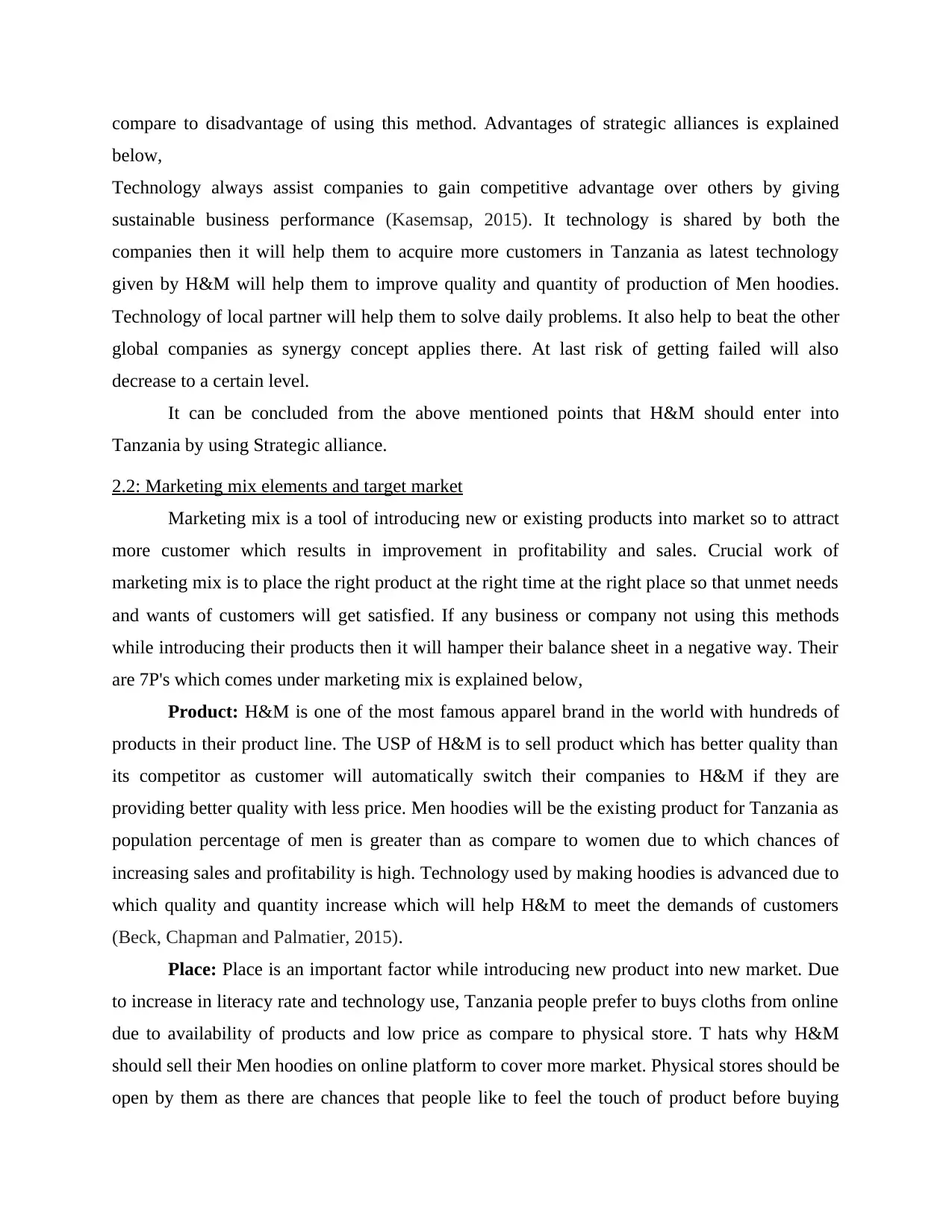
compare to disadvantage of using this method. Advantages of strategic alliances is explained
below,
Technology always assist companies to gain competitive advantage over others by giving
sustainable business performance (Kasemsap, 2015). It technology is shared by both the
companies then it will help them to acquire more customers in Tanzania as latest technology
given by H&M will help them to improve quality and quantity of production of Men hoodies.
Technology of local partner will help them to solve daily problems. It also help to beat the other
global companies as synergy concept applies there. At last risk of getting failed will also
decrease to a certain level.
It can be concluded from the above mentioned points that H&M should enter into
Tanzania by using Strategic alliance.
2.2: Marketing mix elements and target market
Marketing mix is a tool of introducing new or existing products into market so to attract
more customer which results in improvement in profitability and sales. Crucial work of
marketing mix is to place the right product at the right time at the right place so that unmet needs
and wants of customers will get satisfied. If any business or company not using this methods
while introducing their products then it will hamper their balance sheet in a negative way. Their
are 7P's which comes under marketing mix is explained below,
Product: H&M is one of the most famous apparel brand in the world with hundreds of
products in their product line. The USP of H&M is to sell product which has better quality than
its competitor as customer will automatically switch their companies to H&M if they are
providing better quality with less price. Men hoodies will be the existing product for Tanzania as
population percentage of men is greater than as compare to women due to which chances of
increasing sales and profitability is high. Technology used by making hoodies is advanced due to
which quality and quantity increase which will help H&M to meet the demands of customers
(Beck, Chapman and Palmatier, 2015).
Place: Place is an important factor while introducing new product into new market. Due
to increase in literacy rate and technology use, Tanzania people prefer to buys cloths from online
due to availability of products and low price as compare to physical store. T hats why H&M
should sell their Men hoodies on online platform to cover more market. Physical stores should be
open by them as there are chances that people like to feel the touch of product before buying
below,
Technology always assist companies to gain competitive advantage over others by giving
sustainable business performance (Kasemsap, 2015). It technology is shared by both the
companies then it will help them to acquire more customers in Tanzania as latest technology
given by H&M will help them to improve quality and quantity of production of Men hoodies.
Technology of local partner will help them to solve daily problems. It also help to beat the other
global companies as synergy concept applies there. At last risk of getting failed will also
decrease to a certain level.
It can be concluded from the above mentioned points that H&M should enter into
Tanzania by using Strategic alliance.
2.2: Marketing mix elements and target market
Marketing mix is a tool of introducing new or existing products into market so to attract
more customer which results in improvement in profitability and sales. Crucial work of
marketing mix is to place the right product at the right time at the right place so that unmet needs
and wants of customers will get satisfied. If any business or company not using this methods
while introducing their products then it will hamper their balance sheet in a negative way. Their
are 7P's which comes under marketing mix is explained below,
Product: H&M is one of the most famous apparel brand in the world with hundreds of
products in their product line. The USP of H&M is to sell product which has better quality than
its competitor as customer will automatically switch their companies to H&M if they are
providing better quality with less price. Men hoodies will be the existing product for Tanzania as
population percentage of men is greater than as compare to women due to which chances of
increasing sales and profitability is high. Technology used by making hoodies is advanced due to
which quality and quantity increase which will help H&M to meet the demands of customers
(Beck, Chapman and Palmatier, 2015).
Place: Place is an important factor while introducing new product into new market. Due
to increase in literacy rate and technology use, Tanzania people prefer to buys cloths from online
due to availability of products and low price as compare to physical store. T hats why H&M
should sell their Men hoodies on online platform to cover more market. Physical stores should be
open by them as there are chances that people like to feel the touch of product before buying
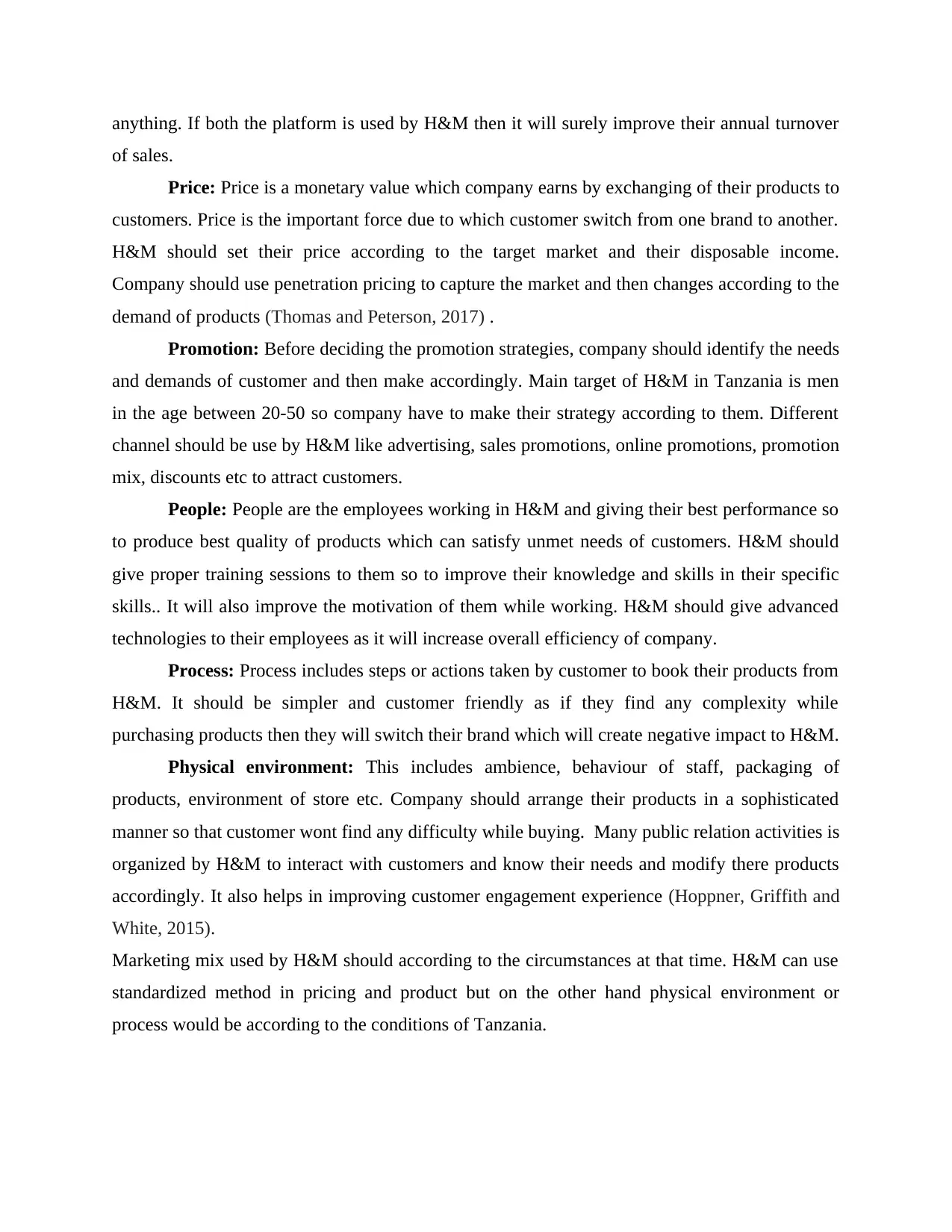
anything. If both the platform is used by H&M then it will surely improve their annual turnover
of sales.
Price: Price is a monetary value which company earns by exchanging of their products to
customers. Price is the important force due to which customer switch from one brand to another.
H&M should set their price according to the target market and their disposable income.
Company should use penetration pricing to capture the market and then changes according to the
demand of products (Thomas and Peterson, 2017) .
Promotion: Before deciding the promotion strategies, company should identify the needs
and demands of customer and then make accordingly. Main target of H&M in Tanzania is men
in the age between 20-50 so company have to make their strategy according to them. Different
channel should be use by H&M like advertising, sales promotions, online promotions, promotion
mix, discounts etc to attract customers.
People: People are the employees working in H&M and giving their best performance so
to produce best quality of products which can satisfy unmet needs of customers. H&M should
give proper training sessions to them so to improve their knowledge and skills in their specific
skills.. It will also improve the motivation of them while working. H&M should give advanced
technologies to their employees as it will increase overall efficiency of company.
Process: Process includes steps or actions taken by customer to book their products from
H&M. It should be simpler and customer friendly as if they find any complexity while
purchasing products then they will switch their brand which will create negative impact to H&M.
Physical environment: This includes ambience, behaviour of staff, packaging of
products, environment of store etc. Company should arrange their products in a sophisticated
manner so that customer wont find any difficulty while buying. Many public relation activities is
organized by H&M to interact with customers and know their needs and modify there products
accordingly. It also helps in improving customer engagement experience (Hoppner, Griffith and
White, 2015).
Marketing mix used by H&M should according to the circumstances at that time. H&M can use
standardized method in pricing and product but on the other hand physical environment or
process would be according to the conditions of Tanzania.
of sales.
Price: Price is a monetary value which company earns by exchanging of their products to
customers. Price is the important force due to which customer switch from one brand to another.
H&M should set their price according to the target market and their disposable income.
Company should use penetration pricing to capture the market and then changes according to the
demand of products (Thomas and Peterson, 2017) .
Promotion: Before deciding the promotion strategies, company should identify the needs
and demands of customer and then make accordingly. Main target of H&M in Tanzania is men
in the age between 20-50 so company have to make their strategy according to them. Different
channel should be use by H&M like advertising, sales promotions, online promotions, promotion
mix, discounts etc to attract customers.
People: People are the employees working in H&M and giving their best performance so
to produce best quality of products which can satisfy unmet needs of customers. H&M should
give proper training sessions to them so to improve their knowledge and skills in their specific
skills.. It will also improve the motivation of them while working. H&M should give advanced
technologies to their employees as it will increase overall efficiency of company.
Process: Process includes steps or actions taken by customer to book their products from
H&M. It should be simpler and customer friendly as if they find any complexity while
purchasing products then they will switch their brand which will create negative impact to H&M.
Physical environment: This includes ambience, behaviour of staff, packaging of
products, environment of store etc. Company should arrange their products in a sophisticated
manner so that customer wont find any difficulty while buying. Many public relation activities is
organized by H&M to interact with customers and know their needs and modify there products
accordingly. It also helps in improving customer engagement experience (Hoppner, Griffith and
White, 2015).
Marketing mix used by H&M should according to the circumstances at that time. H&M can use
standardized method in pricing and product but on the other hand physical environment or
process would be according to the conditions of Tanzania.
⊘ This is a preview!⊘
Do you want full access?
Subscribe today to unlock all pages.

Trusted by 1+ million students worldwide
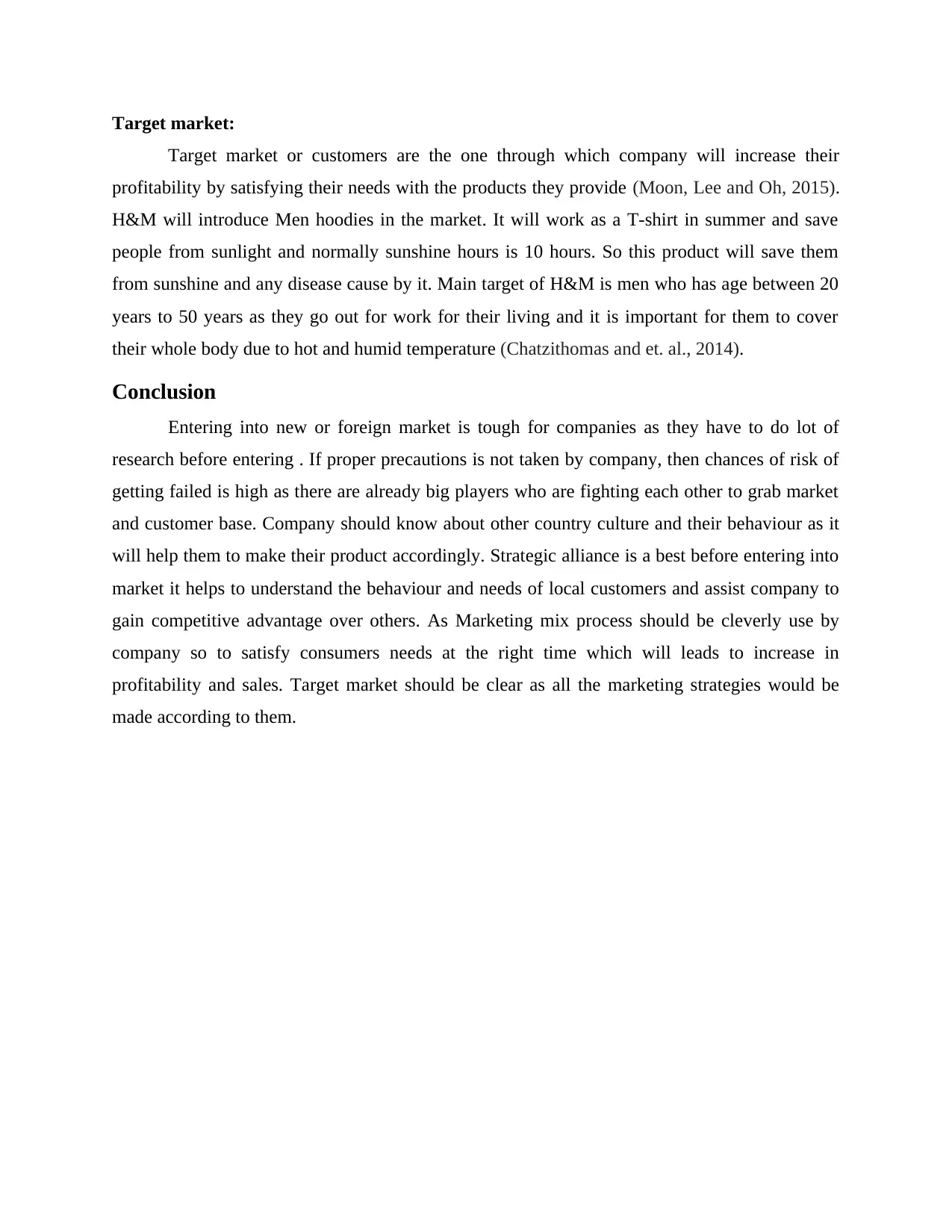
Target market:
Target market or customers are the one through which company will increase their
profitability by satisfying their needs with the products they provide (Moon, Lee and Oh, 2015).
H&M will introduce Men hoodies in the market. It will work as a T-shirt in summer and save
people from sunlight and normally sunshine hours is 10 hours. So this product will save them
from sunshine and any disease cause by it. Main target of H&M is men who has age between 20
years to 50 years as they go out for work for their living and it is important for them to cover
their whole body due to hot and humid temperature (Chatzithomas and et. al., 2014).
Conclusion
Entering into new or foreign market is tough for companies as they have to do lot of
research before entering . If proper precautions is not taken by company, then chances of risk of
getting failed is high as there are already big players who are fighting each other to grab market
and customer base. Company should know about other country culture and their behaviour as it
will help them to make their product accordingly. Strategic alliance is a best before entering into
market it helps to understand the behaviour and needs of local customers and assist company to
gain competitive advantage over others. As Marketing mix process should be cleverly use by
company so to satisfy consumers needs at the right time which will leads to increase in
profitability and sales. Target market should be clear as all the marketing strategies would be
made according to them.
Target market or customers are the one through which company will increase their
profitability by satisfying their needs with the products they provide (Moon, Lee and Oh, 2015).
H&M will introduce Men hoodies in the market. It will work as a T-shirt in summer and save
people from sunlight and normally sunshine hours is 10 hours. So this product will save them
from sunshine and any disease cause by it. Main target of H&M is men who has age between 20
years to 50 years as they go out for work for their living and it is important for them to cover
their whole body due to hot and humid temperature (Chatzithomas and et. al., 2014).
Conclusion
Entering into new or foreign market is tough for companies as they have to do lot of
research before entering . If proper precautions is not taken by company, then chances of risk of
getting failed is high as there are already big players who are fighting each other to grab market
and customer base. Company should know about other country culture and their behaviour as it
will help them to make their product accordingly. Strategic alliance is a best before entering into
market it helps to understand the behaviour and needs of local customers and assist company to
gain competitive advantage over others. As Marketing mix process should be cleverly use by
company so to satisfy consumers needs at the right time which will leads to increase in
profitability and sales. Target market should be clear as all the marketing strategies would be
made according to them.
Paraphrase This Document
Need a fresh take? Get an instant paraphrase of this document with our AI Paraphraser
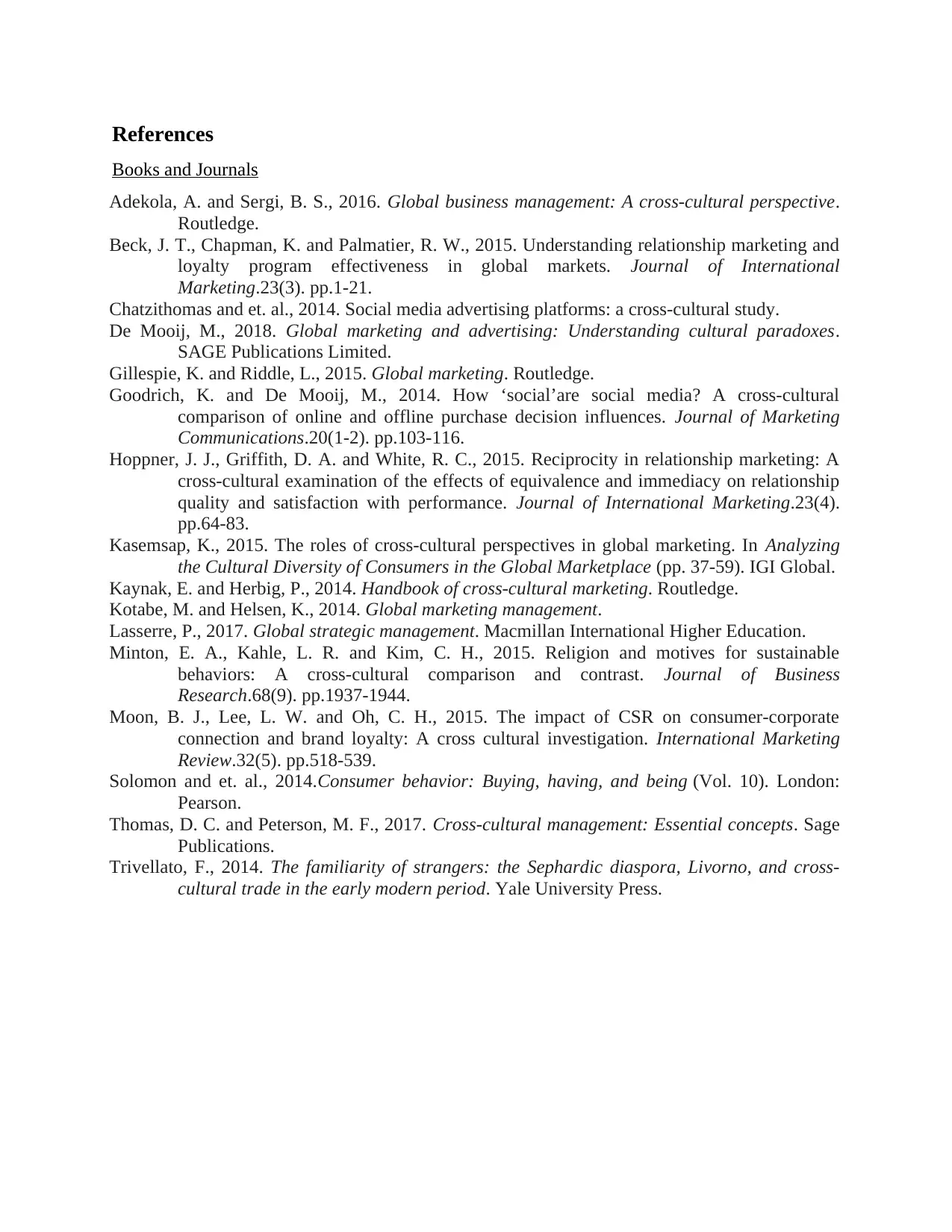
References
Books and Journals
Adekola, A. and Sergi, B. S., 2016. Global business management: A cross-cultural perspective.
Routledge.
Beck, J. T., Chapman, K. and Palmatier, R. W., 2015. Understanding relationship marketing and
loyalty program effectiveness in global markets. Journal of International
Marketing.23(3). pp.1-21.
Chatzithomas and et. al., 2014. Social media advertising platforms: a cross-cultural study.
De Mooij, M., 2018. Global marketing and advertising: Understanding cultural paradoxes.
SAGE Publications Limited.
Gillespie, K. and Riddle, L., 2015. Global marketing. Routledge.
Goodrich, K. and De Mooij, M., 2014. How ‘social’are social media? A cross-cultural
comparison of online and offline purchase decision influences. Journal of Marketing
Communications.20(1-2). pp.103-116.
Hoppner, J. J., Griffith, D. A. and White, R. C., 2015. Reciprocity in relationship marketing: A
cross-cultural examination of the effects of equivalence and immediacy on relationship
quality and satisfaction with performance. Journal of International Marketing.23(4).
pp.64-83.
Kasemsap, K., 2015. The roles of cross-cultural perspectives in global marketing. In Analyzing
the Cultural Diversity of Consumers in the Global Marketplace (pp. 37-59). IGI Global.
Kaynak, E. and Herbig, P., 2014. Handbook of cross-cultural marketing. Routledge.
Kotabe, M. and Helsen, K., 2014. Global marketing management.
Lasserre, P., 2017. Global strategic management. Macmillan International Higher Education.
Minton, E. A., Kahle, L. R. and Kim, C. H., 2015. Religion and motives for sustainable
behaviors: A cross-cultural comparison and contrast. Journal of Business
Research.68(9). pp.1937-1944.
Moon, B. J., Lee, L. W. and Oh, C. H., 2015. The impact of CSR on consumer-corporate
connection and brand loyalty: A cross cultural investigation. International Marketing
Review.32(5). pp.518-539.
Solomon and et. al., 2014.Consumer behavior: Buying, having, and being (Vol. 10). London:
Pearson.
Thomas, D. C. and Peterson, M. F., 2017. Cross-cultural management: Essential concepts. Sage
Publications.
Trivellato, F., 2014. The familiarity of strangers: the Sephardic diaspora, Livorno, and cross-
cultural trade in the early modern period. Yale University Press.
Books and Journals
Adekola, A. and Sergi, B. S., 2016. Global business management: A cross-cultural perspective.
Routledge.
Beck, J. T., Chapman, K. and Palmatier, R. W., 2015. Understanding relationship marketing and
loyalty program effectiveness in global markets. Journal of International
Marketing.23(3). pp.1-21.
Chatzithomas and et. al., 2014. Social media advertising platforms: a cross-cultural study.
De Mooij, M., 2018. Global marketing and advertising: Understanding cultural paradoxes.
SAGE Publications Limited.
Gillespie, K. and Riddle, L., 2015. Global marketing. Routledge.
Goodrich, K. and De Mooij, M., 2014. How ‘social’are social media? A cross-cultural
comparison of online and offline purchase decision influences. Journal of Marketing
Communications.20(1-2). pp.103-116.
Hoppner, J. J., Griffith, D. A. and White, R. C., 2015. Reciprocity in relationship marketing: A
cross-cultural examination of the effects of equivalence and immediacy on relationship
quality and satisfaction with performance. Journal of International Marketing.23(4).
pp.64-83.
Kasemsap, K., 2015. The roles of cross-cultural perspectives in global marketing. In Analyzing
the Cultural Diversity of Consumers in the Global Marketplace (pp. 37-59). IGI Global.
Kaynak, E. and Herbig, P., 2014. Handbook of cross-cultural marketing. Routledge.
Kotabe, M. and Helsen, K., 2014. Global marketing management.
Lasserre, P., 2017. Global strategic management. Macmillan International Higher Education.
Minton, E. A., Kahle, L. R. and Kim, C. H., 2015. Religion and motives for sustainable
behaviors: A cross-cultural comparison and contrast. Journal of Business
Research.68(9). pp.1937-1944.
Moon, B. J., Lee, L. W. and Oh, C. H., 2015. The impact of CSR on consumer-corporate
connection and brand loyalty: A cross cultural investigation. International Marketing
Review.32(5). pp.518-539.
Solomon and et. al., 2014.Consumer behavior: Buying, having, and being (Vol. 10). London:
Pearson.
Thomas, D. C. and Peterson, M. F., 2017. Cross-cultural management: Essential concepts. Sage
Publications.
Trivellato, F., 2014. The familiarity of strangers: the Sephardic diaspora, Livorno, and cross-
cultural trade in the early modern period. Yale University Press.
1 out of 11
Related Documents
Your All-in-One AI-Powered Toolkit for Academic Success.
+13062052269
info@desklib.com
Available 24*7 on WhatsApp / Email
![[object Object]](/_next/static/media/star-bottom.7253800d.svg)
Unlock your academic potential
Copyright © 2020–2025 A2Z Services. All Rights Reserved. Developed and managed by ZUCOL.




